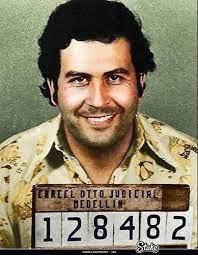
I. Introduction
Pablo Emilio Escobar Gaviria built a cocaine empire that stretched across continents and made him one of the richest and most feared criminals in the world. At the height of his power, Escobar was responsible for the majority of cocaine entering the United States. While based in Colombia, his network ran through Panama, the Caribbean, and Mexico—where he worked with early Mexican drug trafficking groups that would eventually evolve into the powerful cartels we know today.
II. Early Life and Entrance into Crime
Escobar was born on December 1, 1949, in Rionegro, Colombia, and raised in Medellín. From a young age, he was involved in petty crimes—stealing tombstones, smuggling electronics, and forging documents. In the 1970s, he moved into the cocaine trade, quickly rising in the ranks due to his strategic ruthlessness and ambition.
III. Formation of the Medellín Cartel
Escobar co-founded the Medellín Cartel, which rapidly became the dominant force in the global cocaine market. The cartel sourced coca leaves from Peru and Bolivia, processed the drug in Colombia, and smuggled it to the U.S., often using routes through Mexico, Honduras, and the Caribbean.
His motto: “Plata o Plomo” – Silver or Lead – meaning you either took his bribe or took a bullet.
IV. Mexican Connections
Although not Mexican, Escobar’s influence in Mexico was significant. He worked with smugglers and criminal networks to transport cocaine across the U.S.–Mexico border. These connections later helped Mexican cartels, like the Guadalajara Cartel and Sinaloa Cartel, learn from Escobar’s operations and eventually take over much of the cocaine trafficking business after his fall.
V. Power and Public Image
Escobar was worth an estimated $30 billion at his peak. He owned luxury properties, private planes, and even a personal zoo. But he also invested heavily in poor neighborhoods—building homes, schools, and soccer fields. This dual image made him a folk hero to the poor and a terrorist to the state.
VI. Violence and Politics
Escobar’s influence reached the political level. He was elected to Colombia’s Congress in 1982 but was soon expelled when his criminal background became public. In response, he began a brutal war against the government, ordering assassinations of judges, police, and politicians, and carrying out bombings that killed civilians.
VII. Capture and Death
In 1991, Escobar surrendered under a deal that let him build his own luxury prison, La Catedral, which included a nightclub and a waterfall. But when the government tried to transfer him, he escaped. He was finally tracked down and killed on December 2, 1993, on a rooftop in Medellín, after 16 months on the run.
VIII. Lasting Legacy
Even in death, Escobar changed the criminal world. His collapse created a power vacuum that Mexican cartels quickly filled. They adopted many of his tactics—bribery, terror, and paramilitary enforcement—and expanded into new drug markets like methamphetamine and fentanyl.
His life inspired countless movies, books, and TV shows, including Narcos on Netflix.
IX. Conclusion
Pablo Escobar was more than just a drug dealer—he was a symbol of power, corruption, and contradiction. While Colombian, his influence reshaped how drug trafficking operates in Mexico and the rest of Latin America. His story is a lesson in how crime can rise when poverty, politics, and corruption collide—and how difficult it is to dismantle a criminal empire once it takes root.

You must be logged in to post a comment.